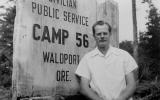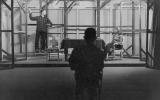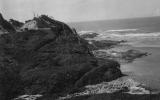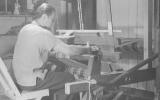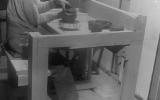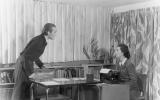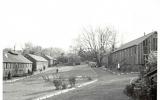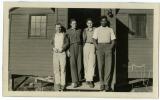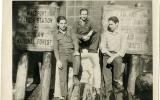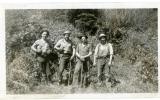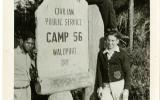CPS Unit Number 056-01
Camp: 56
Unit ID: 1
Operating agency: BSC
Opened: 10 1942
Closed: 4 1946
Workers
Total number of workers who worked in this camp: 336
-
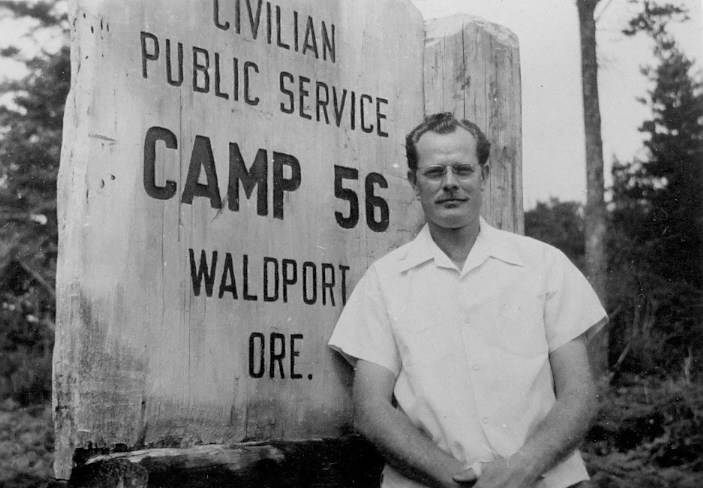 CPS Camp No. 56, Waldport Oregon.George Romine, from Kansas, at camp sign.Digital Image © 2011 Brethren Historical Library and Archives. All Rights Reserved.
CPS Camp No. 56, Waldport Oregon.George Romine, from Kansas, at camp sign.Digital Image © 2011 Brethren Historical Library and Archives. All Rights Reserved. -
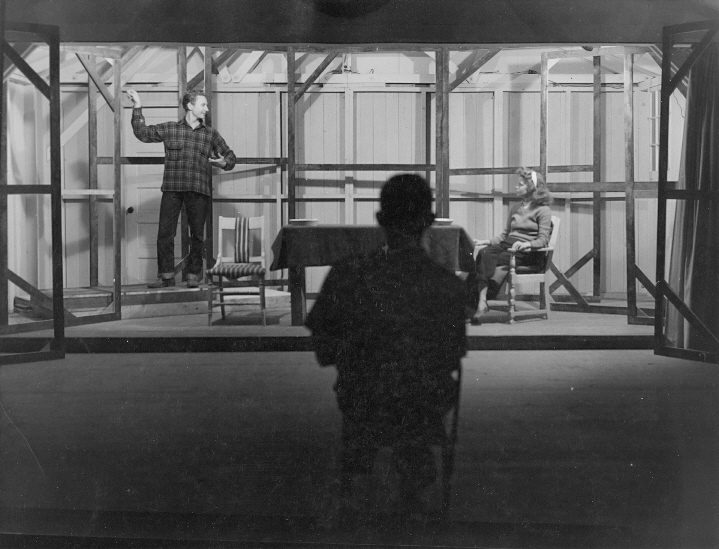 CPS Camp No. 56, Waldport Oregon.Kermit Sheets, left, David Jackson, director, center; Maude Langley, right; Aria da Capo rehearsal & set.Digital Image © 2011 Brethren Historical Library and Archives. All Rights Reserved.
CPS Camp No. 56, Waldport Oregon.Kermit Sheets, left, David Jackson, director, center; Maude Langley, right; Aria da Capo rehearsal & set.Digital Image © 2011 Brethren Historical Library and Archives. All Rights Reserved. -
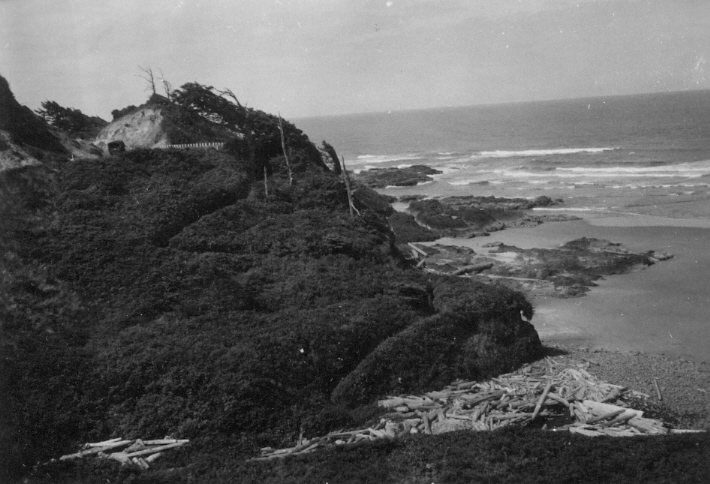 CPS Camp # 56 Waldport, OregonCoastal scene, 7 miles south of campDigital Image Brethren Historical Library and Archives. All Rights Reserved
CPS Camp # 56 Waldport, OregonCoastal scene, 7 miles south of campDigital Image Brethren Historical Library and Archives. All Rights Reserved -
 CPS Camp # 56, Waldport, OregonDon Kimmel at fine arts loomDigital Image Brethren Historical Library and Archives. All Rights Reserved
CPS Camp # 56, Waldport, OregonDon Kimmel at fine arts loomDigital Image Brethren Historical Library and Archives. All Rights Reserved -
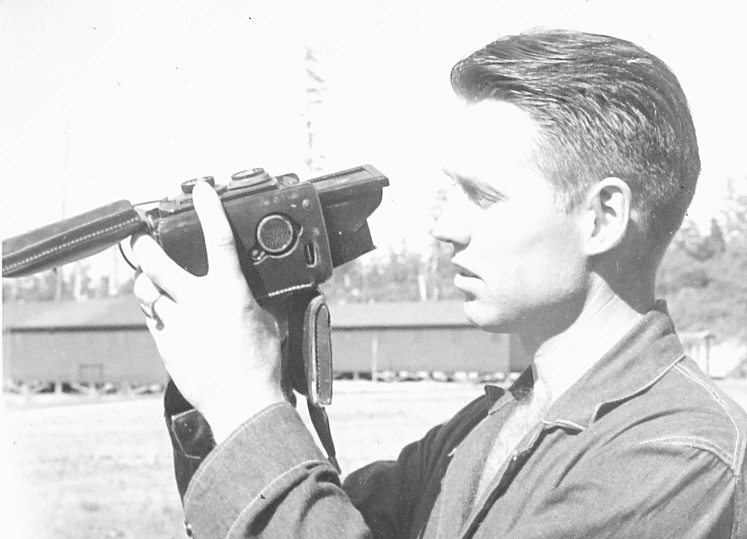 CPS Camp # 56 Waldport, OregonBruce Reeves, photographerDigital Image Brethren Historical Library and Archives. All Rights Reserved
CPS Camp # 56 Waldport, OregonBruce Reeves, photographerDigital Image Brethren Historical Library and Archives. All Rights Reserved -
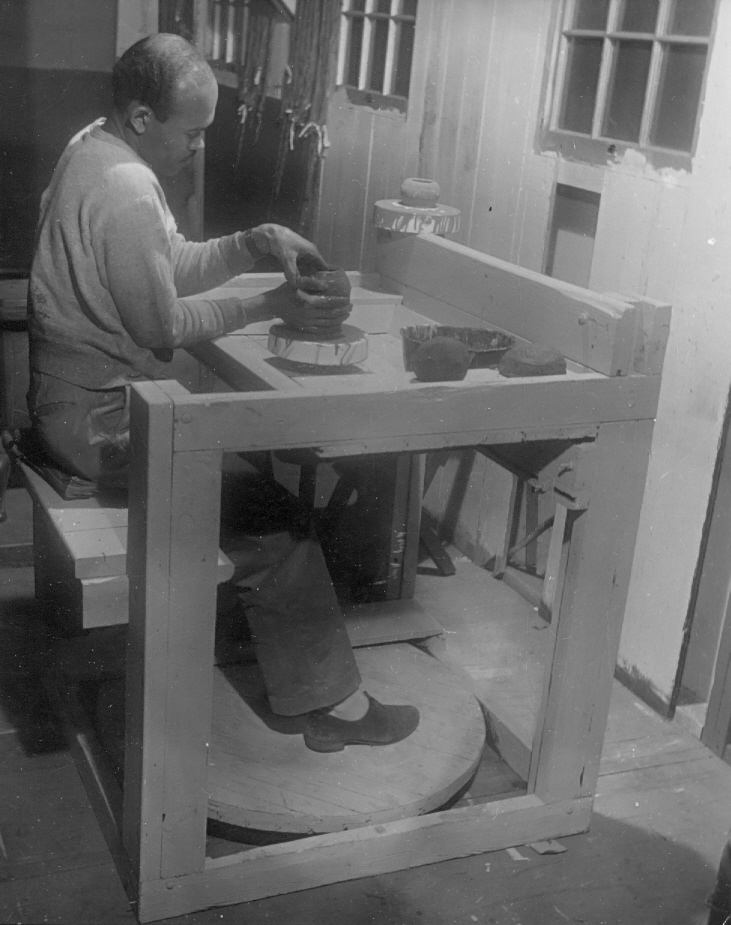 CPS Camp # 56 Waldport, OregonGlen Evans at fine arts pottery wheelDigital Image Brethren Historical Library and Archives. All Rights Reserved
CPS Camp # 56 Waldport, OregonGlen Evans at fine arts pottery wheelDigital Image Brethren Historical Library and Archives. All Rights Reserved -
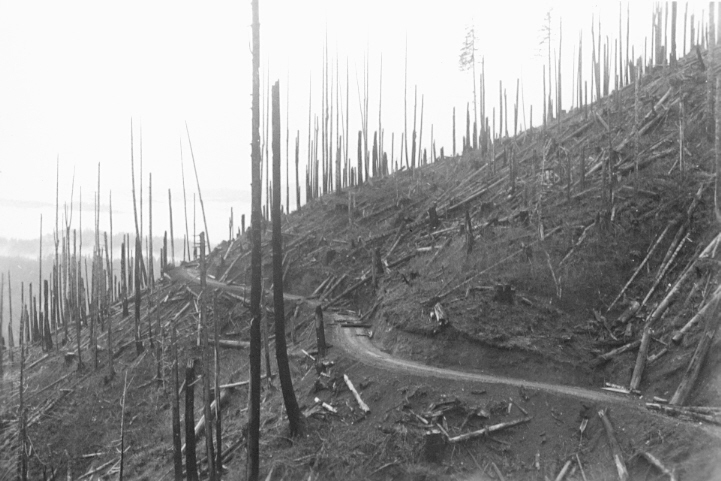 CPS Camp # 56 Waldport, Oregon"Snags"Digital Image Brethren Historical Library and Archives. All Rights Reserved
CPS Camp # 56 Waldport, Oregon"Snags"Digital Image Brethren Historical Library and Archives. All Rights Reserved -
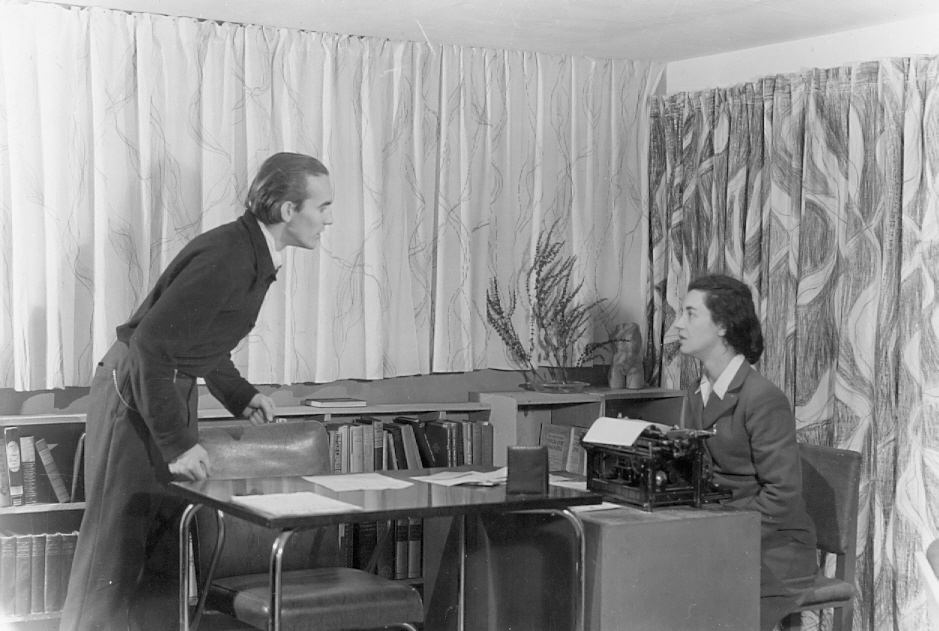 CPS Camp # 56 Waldport, OregonTheater 1 "Marchbanks: Would you talk about indifferent things if a child were by, crying bitterly with hunger?" from Act II of Candida by George Bernard Shaw.Digital Image Brethren Historical Library and Archives. All Rights Reserved
CPS Camp # 56 Waldport, OregonTheater 1 "Marchbanks: Would you talk about indifferent things if a child were by, crying bitterly with hunger?" from Act II of Candida by George Bernard Shaw.Digital Image Brethren Historical Library and Archives. All Rights Reserved -
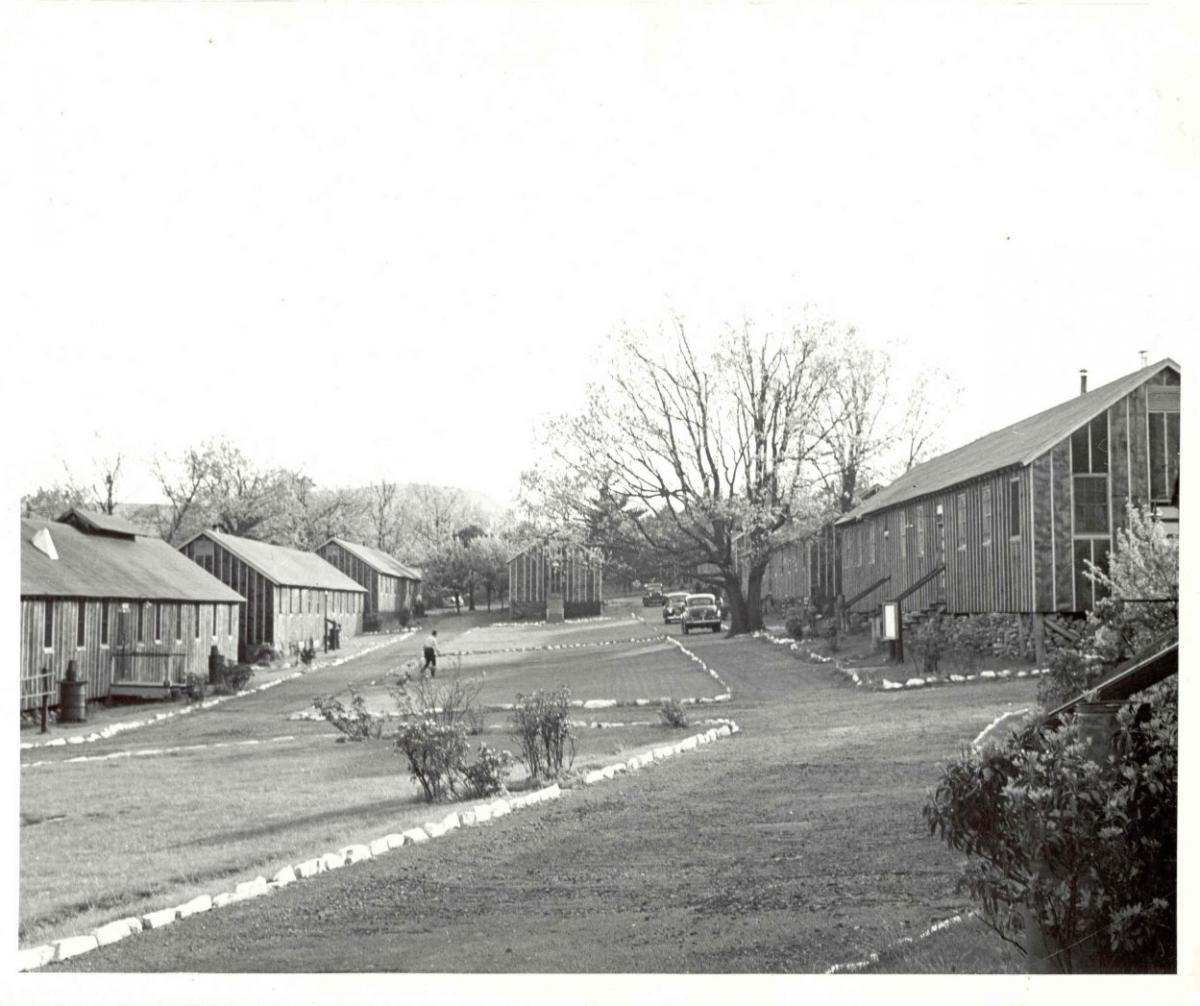 CPS Camp # 56, Waldport Oregon.CPS Camp buildings, typical of many CPS camps, which were orginally built as part of the AMerican Civilian Conservation Corps program during the Depression. This particular camp was administered by the Church of the Brethren. On the back of the photograph is wrtten "CPS Camps, Mennonite Community Association, Scottsdale, Pennsylvania." The photo might have been published in Mennonite Community, and was used by Al Keim in the book: The CPS Story, 1990.Digital image, Photo #5. Box 1, folder 3. MCC Photographs, Civilian Public Service, 1941-1947. IX-13-2.2. Mennonite Central Committee Photo Archive
CPS Camp # 56, Waldport Oregon.CPS Camp buildings, typical of many CPS camps, which were orginally built as part of the AMerican Civilian Conservation Corps program during the Depression. This particular camp was administered by the Church of the Brethren. On the back of the photograph is wrtten "CPS Camps, Mennonite Community Association, Scottsdale, Pennsylvania." The photo might have been published in Mennonite Community, and was used by Al Keim in the book: The CPS Story, 1990.Digital image, Photo #5. Box 1, folder 3. MCC Photographs, Civilian Public Service, 1941-1947. IX-13-2.2. Mennonite Central Committee Photo Archive -
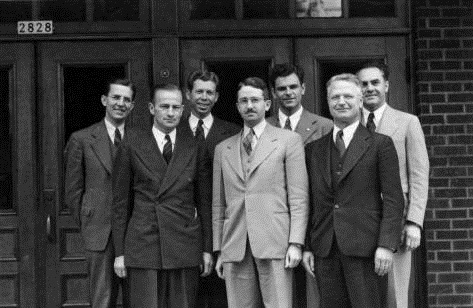 West Coast CPS DirectorsDirectors of the West Coast CPS programs. Dick Mills, director of Camp 56, is in the back row, second from left.Lewis and Clark Digital Collections, Special Collections, Henry and Mary Blocher Collection1943
West Coast CPS DirectorsDirectors of the West Coast CPS programs. Dick Mills, director of Camp 56, is in the back row, second from left.Lewis and Clark Digital Collections, Special Collections, Henry and Mary Blocher Collection1943 -
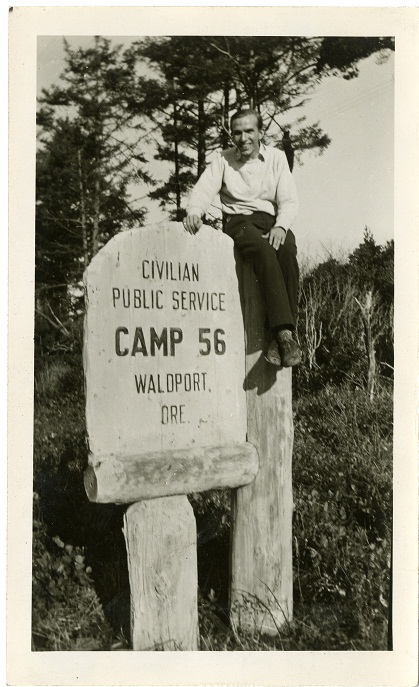 CPS Camp No. 56David Jackson at CPS Camp No. 56.Manchester University Archives and Brethren Historical Collection, Francis Barr CPS Collection, MC2011/233
CPS Camp No. 56David Jackson at CPS Camp No. 56.Manchester University Archives and Brethren Historical Collection, Francis Barr CPS Collection, MC2011/233 -
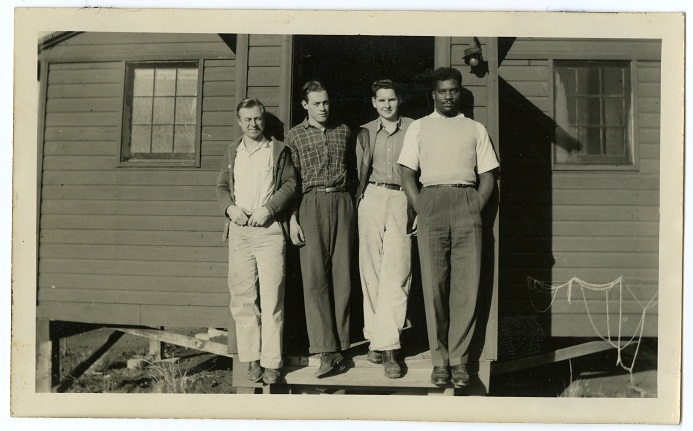 CPS Camp No. 56Harry McNeary, Don Fillmore, Lloyd Brandt, and Olie Olson at Camp 56.Manchester University Archives and Brethren Historical Collection, Francis Barr CPS Collection, MC2011/233
CPS Camp No. 56Harry McNeary, Don Fillmore, Lloyd Brandt, and Olie Olson at Camp 56.Manchester University Archives and Brethren Historical Collection, Francis Barr CPS Collection, MC2011/233 -
 CPS Camp No. 56The "Sign Shop Gang" at Camp 56. From left to right: Francis Barr, Wilbur Stuckey, Don Fillmore.Manchester University Archives and Brethren Historical Collection, Francis Barr CPS Collection, MC2011/233
CPS Camp No. 56The "Sign Shop Gang" at Camp 56. From left to right: Francis Barr, Wilbur Stuckey, Don Fillmore.Manchester University Archives and Brethren Historical Collection, Francis Barr CPS Collection, MC2011/233 -
 CPS Camp No. 56A.J.R. Penney, Francis Barr, Warren Sanger, and Ernie Barr at Camp 56, Waldport, Oregon.Manchester University Archives and Brethren Historical Collection, Francis Barr CPS Collection, MC2011/233
CPS Camp No. 56A.J.R. Penney, Francis Barr, Warren Sanger, and Ernie Barr at Camp 56, Waldport, Oregon.Manchester University Archives and Brethren Historical Collection, Francis Barr CPS Collection, MC2011/233 -
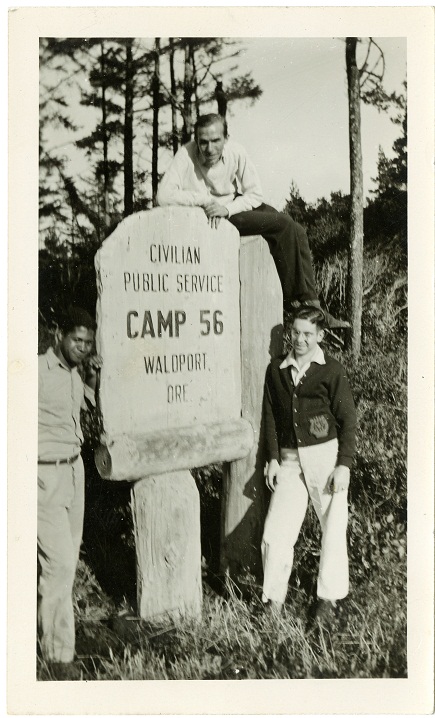 CPS Camp No. 56Left to right: John Johnson, David Jackson, Francis Barr at Camp 56, Waldport, Oregon.Manchester University Archives and Brethren Historical Collection, Francis Barr CPS Collection, MC2011/233
CPS Camp No. 56Left to right: John Johnson, David Jackson, Francis Barr at Camp 56, Waldport, Oregon.Manchester University Archives and Brethren Historical Collection, Francis Barr CPS Collection, MC2011/233
CPS Camp No. 56, a Forest Service camp located very close to the ocean at Waldport, Oregon and operated by the Brethren Service Committee, opened in October 1942 and closed in April 1946. The men fought fires, worked to prevent them and maintained equipment, roads and trails. During 1943-44 the men created a School for Fine Arts.
The second CPS camp in Oregon, also known as Camp Angel, was located a short distance from the ocean near the town of Waldport on the Alsea River which empties into the Alsea Bay on the Oregon Coast .
Directors: C. E. Kimmel, Richard Mills, Harold Cessna, Enoch Crumpton
Ten men from CSP Camp No. 21 at Cascade Locks transferred to Waldport. A February 1, 1944 brochure describing the Waldport School for Fine Arts and its facilities was mailed to all CPS camps. Men with interests and experience in the creative arts transferred into the camp, at a time when many were disillusioned with the demeaning nature of work in the base camps.
Some of the men were married. In general, about half of the men in Brethren camps tended to report religious affiliation as Brethren with the other half reporting various other denominational affiliations.
The men worked to reforest the Blodgett Peak Burn, forest land heavily logged during World War I, and later burned by devastating wildfires. The men felled hundreds of dead trees, replanted logged-out and burned out areas while also caring for seedlings in nurseries.
Fire fighting required intense work away from camp for short periods of time until fires could be brought under control. Men also performed maintenance and operation of two-way radio sets, telephone equipment and kept tools and equipment in repair.
When fire hazards were low, they built roads and trails in the back country and felled hundreds of dead trees. They maintained and built forest lookout systems and also staffed these posts.
Special schools provided major contributions to camp life, as a group of men with particular specialized interests would pursue those together in a systematic fashion. Selective Service permitted men to transfer from base camps to camps or units that provided a closer match to their interests. Further, the Brethren Service Committee valued grounding camp courses and programs in pacifism.
The School for Fine Arts at Waldport, proposed by William Everson with help from Kermit Sheets and Kemper Nomland at Cascade Locks, received the support of Morris Keeton, the national director of education for Brethren camps. Because the men believed that the group should be both a producing group and a study group, they were targeting both experienced and beginning artists. The Waldport nucleus of artists expressly wanted to avoid a typical academic curriculum.
A brochure written by poet William Everson described the school as “a group of pacifists devoted to the arts”, and suggested that such a community would be guided by the unifying principle of pacifism. An active group of artists transferred to the camp, interested in individual and group expression in literature, music, speech, creative crafts, visual and dramatic arts. The location, good physical facilities and a printing press with type all supported the goals for the school.
While the organization was informal, William Everson served as member-director. Manche Langley, a pacifist volunteer who lived in Portland, rented a cabin near the camp, designating herself Waldport’s “USO girl”. She began work as an assistant for the fine arts program, eventually running the printing press. Described as “a kindred spirit among the camp’s many artists and musicians”, she reportedly contributed greatly to the activities through “her enthusiasm and outrageous activities”. (Goossen p. 53)
Literary contributions included collections of poems, short stories and essays (William Everson’s War Elegies and Waldport Poems; Glen Coffield’s Horned Moon).
The theatre group presented some fifteen weekly programs of play readings, each with an artistic program folder. They performed a number of plays, including A Morality Play for the Leisured Class, and Tennessee Justice, compiled and directed by Martin Ponch of the Fine Arts Group. The group held regular play readings to involve more at the camp. They produced Chekhov’s The Seagull , Ibsen’s Ghosts and Shaw’s Candida.
The men produced a concert series, presented violin and piano recitals, and other musical events, each described in screen-printed programs. One musician at Waldport, Broadus Erle, later joined the Yale University music faculty.
In the visual arts, men produced paintings, sketches, drawings, clay sculpture, weaving and printmaking.
Kermit Sheets, a high school drama teacher, and Kemper Nomland, artist, both transfers from Cascade Locks, brought the literary magazine The Illiterati and served as editors of two more issues. The second issue asked the question “But is art important to pacifism?” The editors concluded “It is essential for the pacifist to present his philosophy to the haunters of libraries, concerts and galleries, as it is for him to include his philosophy in the relief and reconstruction he plans to carry on after the war” (Illiterati 2:1 in Kovac p. 97).
After the conclusion of the war and the closing of CPS Camp No. 56 at Waldport, Kemper Nomland and William Eshelman took the press to Southern California where they published two more issues of Illerati, No. 5 (1948) and No. 6 (1955).
While the Waldport camp newspaper called The Tide was published from 1942 through May 1944, the Fine Arts Group decided to publish The Untide in early 1943.
The Untide Press published ten monographs, among those small poetry collections including The Horned Moon by Glen Coffield, Generation of Journey by Jacob Sloan, and two of William Everson’s books, X War Elegies and The Waldport Poems. The cover design by Kemper Nomland for An Astonished Eye Looks out of the Air by Kenneth Patchen (1945) inspired the design for the Pocket Poets series published by City Light Books ten years later.
The men also published at least one unnumbered and undated issues of Good News, according to the Swarthmore College Peace Collection CPS Archives.
Martin Ponch, who had transferred from Cascade Locks, brought Compass Magazine, the last two issues of which were published at Waldport (Vol. 2 Spring/Fall 1944; the Art and Literary Issue in 1945).
Isabelle Mount Miller recalled her association with the musicians, poets and other artists at CPS Camp No. 56 as “exhilarating—the greatest experience of my life, and they are still our friends scattered all over”. (Goossen p. 125)
Several men from the Fine Arts Group at Waldport supported the Cascade Locks strike on April 24, 1946, protesting the transfer of two men to the government camp at Minersville, California. As the strike continued, the men sent press releases and letters asking for financial support and expressing their support of the men at Glendora and Minersville in California, as well as at Big Flats, New York. Since hostilities had ceased, the fundamental complaint was that CPS men continued to be required to serve without pay.
See Katrine Barber and Eliza Elkins Jones, “The Utmost Human Consequence”, Oregon Historical Quarterly 107:4 (2006): 510-535 discussing the lives of Kermit Sheets and Manche Langley.
See Katrine Barber’s extensive collection of oral history interviews of men and women who spent time at Waldport, Camp 56: An Oral History Project: Conscientious Objectors and the Waldport, Oregon Civilian Public Service Camp, http://www.ccrh.org/oral/co.pdf
See Leslie Eisan, Pathways of Peace: A History of the Civilian Public Service Program Administered by the Brethren Service Committee. Elgin, IL: Brethren Publishing House, 1948.
For more information on women COs see Rachel Waltner Goossen, Women Against the Good War: Conscientious Objection and Gender on the American Home Front, 1941-47. Chapel Hill, NC: The University of North Carolina Press, 1997.
See also Jeffrey Kovac, Refusing War Affirming Peace: A History of Civilian Public Service Camp No. 21 at Cascade Locks. Corvallis, OR: Oregon State University Press, 2009.
For documents on Oregon CPS camps, see Lewis and Clark College Special Collections, http://digitalcollections.lclark.edu/
For a catalog of an exhibition of the publishing at Waldport, see http://digitalcollections.lclarl.edu/cdm4/item_viewer.php?CISOROOT=/pubs&CISOPTR=23&CISOBox=1&REC=4
For a discussion of the creative work of Kermit Sheets and Kemper Nomland, see http://digitalcollection.lclark.edu/cdm4/item_viewer.php?CISOROOT=/pubs&CISOPTR=41&CISOBOX=1&REC=20
Swarthmore College Peace Collection, Camp periodicals database.
Swarthmore College Peace Collection, Conscientious Objection in America: Listing of Primary Sources.
